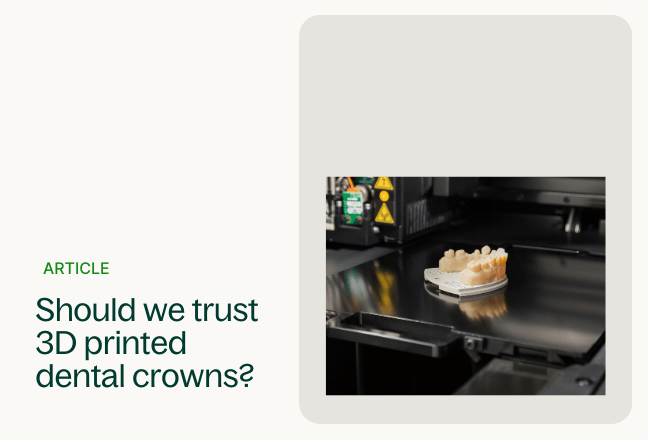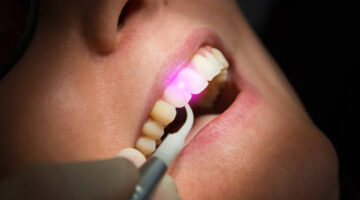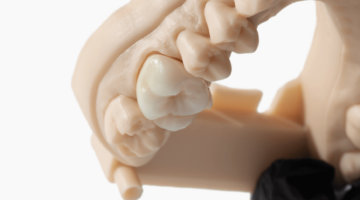The technology behind 3D printing has been improving for nearly four decades, providing increasingly precise fabrication for everything from game pieces and toys to machine and manufacturing parts. In dentistry, the practice is becoming proliferated as its advantages scale with its accelerated improvements.
Essentially, 3D printing was a fringe technology that’s increasingly moving into the mainstream as it becomes more affordable and reliable. Early implementations of 3D printing in dentistry have primarily included diagnostic models and surgical guides—tools for dentists that require precision but not strength, and help guide treatment without actually replacing teeth. As the technology has improved, however, 3D printed dental crowns are now up for debate. Can we trust the technology that quickly prints guides and models to make teeth replacements up to the standard of, say, zirconia or eMax crowns made with CAD/CAM workflow?
And what exactly are 3D printed crowns made of? How strong are they, and how reliable can we trust them to be?
What are 3D dental crowns made of? How are 3D crowns made?
One absolute truth about the 3D printing process is that, up front, it’s easier on patients, dental staff, and dentists. Patients don’t have to sit through uncomfortable impressions, and practices don’t have to mail impressions away—similar to the seamless process of sending your digital impressions to Dandy. Once a 3D crown printing lab has the digital map of a patient’s mouth, they can (with the dentist) design a prosthetic, which is then fabricated by a 3D printer—digitizing each step of this process turns days and weeks into hours. After printing, a crown is “prepared,” meaning it is cleaned, inspected, and cured.
That said, most dentists are still using CAD/CAM and traditional milled crowns so that they can access the strength and durability of Zirconia, eMax, and even traditional ceramic crowns, because the truth of the matter is: 3D printed crowns are made from glorified composite resin.
One thing this translates to for the patient is cheaper, quicker crowns. Removing time-consuming milling from the process guarantees a quicker and more cost-efficient turnaround. And 3D printed crowns are definitionally accurate and precise. The process of intraoral scanning, digital impressions, and printed tooth replacements guarantees a level of precision slightly above milled or hand-fabricated prosthetics. But how strong are they? How long will they last?
How strong are 3D printed crowns?
We live in an age of restorative tooth abundance—there are many options from which clinicians and patients can select crowns. But all crowns are not created equal. 3D printed crowns are essentially a layered composite, and while 3D printed eMax may come in the future, it’s clear for now that 3D printed dental crowns are a solid temporary option that lack the strength and durability to be a reliable long-term restorative option in their current state.
Still, there are indications that the flexural strength of 3D printed crowns might be suitable for interim prosthetic crowns, and while the process compares favorably to conventional resins, we’re a significant wait from something that can compete with the strength and durability of milled zirconia and eMax crowns.
How aesthetic are 3D printed crowns?
As for the trade-off vis-a-vis that strength concession: turns out, the aesthetics aren’t probably worth it, either. While one of the great strengths of 3D printing is personalization, and the process enables near-perfect precision in shape and design, the limitations of the production medium keep clinicians also wanting more when it comes to aesthetics. Because only one shade can be printed at once, 3D printed restorations and temporary crowns must then be stained, leaving a tooth replacement that is opaque and monochromatic.
Again, as a temporary, while waiting for a milled zirconia or even metal replacement, a 3D printed crown can get the job done. But for a longer (5+ years) restoration, you will find the aesthetic quality as lacking as the durability.
Should you look for a dental lab that 3D prints crowns?
Clinicians and dental practices are happiest with outsourced lab work when the money they save is not at the cost of quality. Dental labs that mill zirconia, for example, can dependably offer durable, cost-effective crowns that typically last more than five years, according to studies.
And when things fail—whether because prematurely of fabrication issues and failure, or if the patient cracks the crown—a dentist doesn’t have the luxury of solving the problem in-house. Seek out a dental laboratory that works fast, creates high-quality fabrications, and has measures in place to make dealing with failure easy and stress-free. Don’t skimp on quality while 3D printing is so far behind, especially when Dandy offers a variety of superior alternatives and helps you set up digital, intraoral scanning to streamline best practices, save time, and improve patient outcomes with better, more reliable fabrications.
Should you 3D print crowns in-house?
We’ve already given ample reason to eschew most 3D printed crowns from external labs. The technology is coming, but it’s not there, and the product is simply inferior to milled alternatives from external labs.
If you want to 3D print other devices, like temporary crowns, aligners, and nightguards, you may join the many dentists mulling the decision to bring 3D printing and lab work in-house. If you have the scale, size, and appetite for problem-solving, you can add an in-house lab to a multi-office practice and achieve modest benefits. But to produce these benefits, you’ll need to hire part- or full-time team members solely to maintain and run your lab. Add a 3D printing system, and your lab expert will need additional training. Your practice will be purchasing and inventorying 3D printing materials, and the liability attached to poor-quality results will be yours alone.
If you want a lab, you should build a lab, but it’s worth understanding the costs and benefits—not just of the lab itself, but of 3D printing—before taking on the substantial project of in-house lab work.
So, should your practice start offering 3D printed dental crowns?
Like so many modern advancements that feel almost magical in the benefits and ease they provide to industry, and any excitement over the tech is more than valid. If you’re passionate about 3D printing, you should continue to follow the development of the technology and wait for the right time to incorporate it into your practice. But truthfully, when it comes to 3D printing’s role in dentistry, it might not be the right time yet.
3D printed crowns provide temporary quality at savings that don’t yet justify the expense, especially with solid, durable options like zirconia and eMax leading the way. And committing to 3D printing in-house is committing to all the costs and headaches of having your own lab: additional labor, training, inventory, process, and dedication of physical space to the lab equipment. There is a place for 3D printing in dentistry, but for crowns, today, we might still be waiting for the right alignment of tech and timing.



